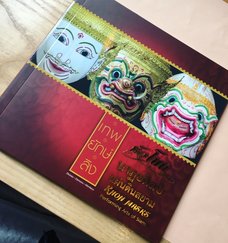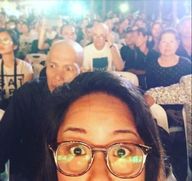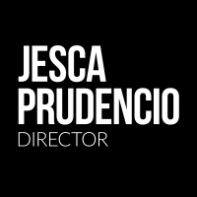
ABOUT KHON
Khon is the traditional royal mask drama performance of Thailand. It is known for its detailed masks, sparkling costumes, and intricate acrobatic movement. The characters and stories are all based on the Ramayana, which is of the same world as the Kohn puppet show I witnessed at Baan Silapin. The mask performance goes back even further to the Ayutthaya Era from the 14th century. Each khon character is distinguished by the specific craftsmanship of each mask. There are three kinds of characters: the divines, the giant demons (Tosakanth), and the monkeys (Hanuman). The stories are usually based on the Hanuman protecting the humans, and fighting against the giants. I was able to pick up a copy of book at local store that details the all aspects of the kohn mask performance, and each character. This has been my reference and bible when it comes to understanding the form. The masks cover the entire face and head, with only two small holes for the performers to see through. This restriction, paired with tightly fitted ornate costumes, and athletic movement, this is a challenging form.
I have tried to study it while I am here, but the reality is that it mainly for men, and one must study it for years led by a master one of the few schools that still teach Khon. After coming to grips with this reality, I decided to attend as many performances as possible. Here is my experience witnessing a live khon performance for the first time.
THE PERFORMANCE
There are very few chances to actually witness a full Kohn mask drama, but I was lucky enough to get front seat views of a public performance for The Thai Festival located in Lumphini Park on January 28th. The crowd was packed with locals, tourists pausing for a quick Facebook post, and me - an American theater fangirl who researched this form and found her way to this performance. I was mesmerized by the glowing masks and costumes. Up close the mask and costumes seem over the top, but in an open park, it drew our eyes to every intricate movement. Students always ask me, “What makes a good actor?” My answer remains the same, “When I feel the actor surrenders to the character.” Here we will see excerpts of “Yok Rop” performed by the College of Dramatic Arts, one of the few schools that still teach the form.
A few things to note during the clip excerpts:
Khon is the traditional royal mask drama performance of Thailand. It is known for its detailed masks, sparkling costumes, and intricate acrobatic movement. The characters and stories are all based on the Ramayana, which is of the same world as the Kohn puppet show I witnessed at Baan Silapin. The mask performance goes back even further to the Ayutthaya Era from the 14th century. Each khon character is distinguished by the specific craftsmanship of each mask. There are three kinds of characters: the divines, the giant demons (Tosakanth), and the monkeys (Hanuman). The stories are usually based on the Hanuman protecting the humans, and fighting against the giants. I was able to pick up a copy of book at local store that details the all aspects of the kohn mask performance, and each character. This has been my reference and bible when it comes to understanding the form. The masks cover the entire face and head, with only two small holes for the performers to see through. This restriction, paired with tightly fitted ornate costumes, and athletic movement, this is a challenging form.
I have tried to study it while I am here, but the reality is that it mainly for men, and one must study it for years led by a master one of the few schools that still teach Khon. After coming to grips with this reality, I decided to attend as many performances as possible. Here is my experience witnessing a live khon performance for the first time.
THE PERFORMANCE
There are very few chances to actually witness a full Kohn mask drama, but I was lucky enough to get front seat views of a public performance for The Thai Festival located in Lumphini Park on January 28th. The crowd was packed with locals, tourists pausing for a quick Facebook post, and me - an American theater fangirl who researched this form and found her way to this performance. I was mesmerized by the glowing masks and costumes. Up close the mask and costumes seem over the top, but in an open park, it drew our eyes to every intricate movement. Students always ask me, “What makes a good actor?” My answer remains the same, “When I feel the actor surrenders to the character.” Here we will see excerpts of “Yok Rop” performed by the College of Dramatic Arts, one of the few schools that still teach the form.
A few things to note during the clip excerpts:
- Similar hyperextended finger, wrist, and arm shapes as the Thai classical dance
- Similar extreme second position with feet pointed out, in a squat
- The first mask is the giant. His movements are heavy, abrupt
- The second mask is the monkey. His movements are light and athletic.
- The human (prince) character is guarded by the monkey. His face has makeup almost painted as a mask. His facial expressions do not move, to match the mask like qualities of his surrounding ensemble.
- The music is live. The lyrical singing and spoken text is done by the music ensemble working as one with the masked dancer.
- During the final battle, it is much more of a dance to hit images rather than any sort of martial arts. The dancers are creating perfect pictures hitting one movement to the next.

POST-PERFORMANCE
This was by far the most impressive traditional performance I had ever seen in Thailand. It definitely lived up to my expectations. Although there were rough moments with the ensemble in training, I felt a sense of real specificity, craft, and mastery. The epic scale is a major part of this wow factor. There were probably thirty performers and then another twenty person music and voice ensemble. I have felt a similar experience going to the symphony or the ballet. When using form in theatrical performance, it is important to create your own language. I don't see myself using Khon exactly, but I appreciate seeing all the elements working in a perfect puzzle. My friends ask me why I am interested in traditional performance. If I am going to work with Thai artists, and be part of the community, I want to understand the performance culture and its originals. Today, I witness performances that are very directly related to Khon and some that completely blatantly reject it.
Looking at the audience around me in Lumpini park that night, I was pleased to see how many Thai people were in attendance. Mostly an older generation marveling at the beauty. In speaking with my Thai friends, they said that there are Khon performances that occur on a commercial scale in Bangkok, but all advertising is in Thai. They were impressed that I was able to find this performance on my own. This has been a constant struggle for me, in attending traditional and contemporary performance. If there advertising is not in English, than I don't have access to it. When I do get to witness it like tonight, it is a treat because it is not a tourist trap. But then I think of all the other things I could be missing, because I am not able to find more information on it. Thankfully I have friends who have translated some flyers and events for me. So now I know I have to work a little bit harder to see authentic performances here in Thailand!
FYI...
There is not a lot of information on the College of Dramatic arts available on English. Here is a link to their Facebook page with updates on recent performances and events. To get in contact with the school, I suggest connecting with a translator to assist with communication!
www.facebook.com/pages/The-College-of-Dramatic-Arts-/467455059933703https://www.facebook.com/pages/The-College-of-Dramatic-Arts-/467455059933703
This was by far the most impressive traditional performance I had ever seen in Thailand. It definitely lived up to my expectations. Although there were rough moments with the ensemble in training, I felt a sense of real specificity, craft, and mastery. The epic scale is a major part of this wow factor. There were probably thirty performers and then another twenty person music and voice ensemble. I have felt a similar experience going to the symphony or the ballet. When using form in theatrical performance, it is important to create your own language. I don't see myself using Khon exactly, but I appreciate seeing all the elements working in a perfect puzzle. My friends ask me why I am interested in traditional performance. If I am going to work with Thai artists, and be part of the community, I want to understand the performance culture and its originals. Today, I witness performances that are very directly related to Khon and some that completely blatantly reject it.
Looking at the audience around me in Lumpini park that night, I was pleased to see how many Thai people were in attendance. Mostly an older generation marveling at the beauty. In speaking with my Thai friends, they said that there are Khon performances that occur on a commercial scale in Bangkok, but all advertising is in Thai. They were impressed that I was able to find this performance on my own. This has been a constant struggle for me, in attending traditional and contemporary performance. If there advertising is not in English, than I don't have access to it. When I do get to witness it like tonight, it is a treat because it is not a tourist trap. But then I think of all the other things I could be missing, because I am not able to find more information on it. Thankfully I have friends who have translated some flyers and events for me. So now I know I have to work a little bit harder to see authentic performances here in Thailand!
FYI...
There is not a lot of information on the College of Dramatic arts available on English. Here is a link to their Facebook page with updates on recent performances and events. To get in contact with the school, I suggest connecting with a translator to assist with communication!
www.facebook.com/pages/The-College-of-Dramatic-Arts-/467455059933703https://www.facebook.com/pages/The-College-of-Dramatic-Arts-/467455059933703


 RSS Feed
RSS Feed